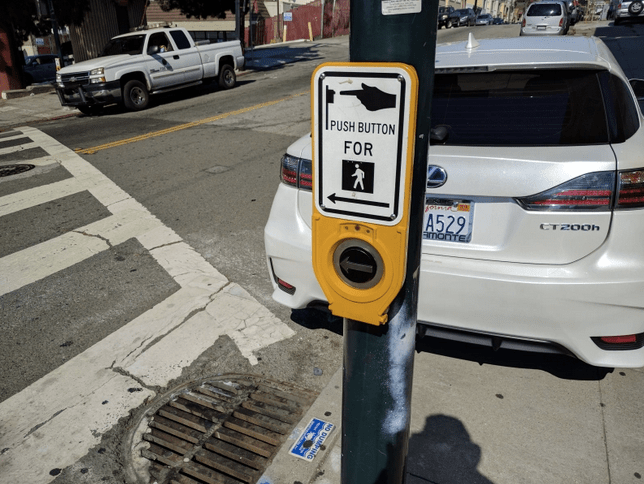Under the heading of improving bus speeds, AC Transit, in coordination with Berkeley, Oakland, and other cities, is installing more "pedestrian actuation" buttons, also known as "beg buttons," on streets with major bus lines.
"It's something they can do in the dead of night without any public outreach," explained advocate and AC Transit Board Director Jean Walsh, in a phone interview with Streetsblog. "I understand you don't want a community meeting for every single change, but they're calling it 'signal improvements.' Then you dig in and it's 'pedestrian actuation,' which cities do without any input."
Indeed, improvements to AC Transit lines include signal upgrades to keep lights green a bit longer so buses can pass. And, as Walsh opined, it's probably not a terrible thing if a pedestrian has to wait as well for a few seconds longer to allow a bus to get through an intersection. The problem is the double standard--motorists on cross streets with major bus lines get a green automatically. Pedestrians, on the other hand, have to come to the intersection, push the button, and then often wait through entire signal cycles before they can cross, making it even harder to walk anywhere in the East Bay--including to a bus stop.
"AC Transit includes 'crosswalk push button' systems in proposed street designs for bus route improvement, where applicable. As you know, we are not a city agency but instead operate in 13 cities and unincorporated areas. Ultimately, the activation of 'crosswalk push buttons' is determined by the engineers of the individual municipality," explained AC Transit's Robert Lyles.
Streetsblog reached out to Oakland and will update this post. Meanwhile, "Oakland typically adds them when a signal is replaced, which is an expensive proposition and usually only happens with grant funding or via a standalone capital project," explained Bike East Bay's Robert Prinz. "For instance, a bunch of signals around Lake Merritt BART were replaced a few years back, as were most of the signals via the East Bay BRT project, both of which added beg buttons at many locations, as well as countdown displays."
"There is indeed usually no public communications or outreach around these types of signal changes," he added. "The assumption from OakDOT (wrong, in my opinion) appears to be that physical changes to streets require a substantial community involvement, but signal operations changes can be implemented with no public process."
Walsh, meanwhile, took video of the intersection of Shattuck and Alcatraz in Oakland to show how the new beg buttons give pedestrians the absolute lowest priority, sometimes forcing them to wait through entire signal cycles before they can cross legally.
From Streetsblog's view, this is exactly the kind of implementation that flies in the face of equity. If someone is on foot, riding a bike, or driving a car, they deserve an equitable environment where everyone can safely and comfortably get to their destination. And buses full of people doing the least damage to the environment and taking up the least amount of space clearly should have preemption, not just "priority," over cross traffic--lights should cycle to green or stay green as a bus approaches.
But that doesn't mean pedestrians should be given short shrift by making them push a button and wait through an entire cycle of the light before they are forced to dash across every intersection whether or not a bus is approaching, as seen in Walsh's video. That's clearly giving them lower priority--far lower in fact--than individuals in private automobiles. Many of those pedestrians are also AC Transit bus riders walking to and from their buses, so in effect, when cities add "beg buttons" at the request of AC Transit, they are often transferring bus delay to their own riders, which doesn't make a whole lot of sense. Streetsblog watched a video meeting in Berkeley about plans to speed up buses on Telegraph where Will Buller, a Traffic Engineer with AC Transit, argued that pedestrian beg buttons make the intersection more efficient.
But more efficient for whom? Walsh, meanwhile, is meeting about this issue with Berkeley officials to advocate for a more balanced approach so its crossing buttons help speed up buses, but also prioritize pedestrians over people in private cars.






